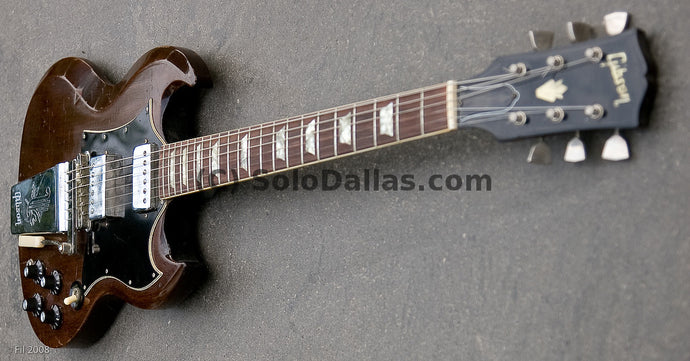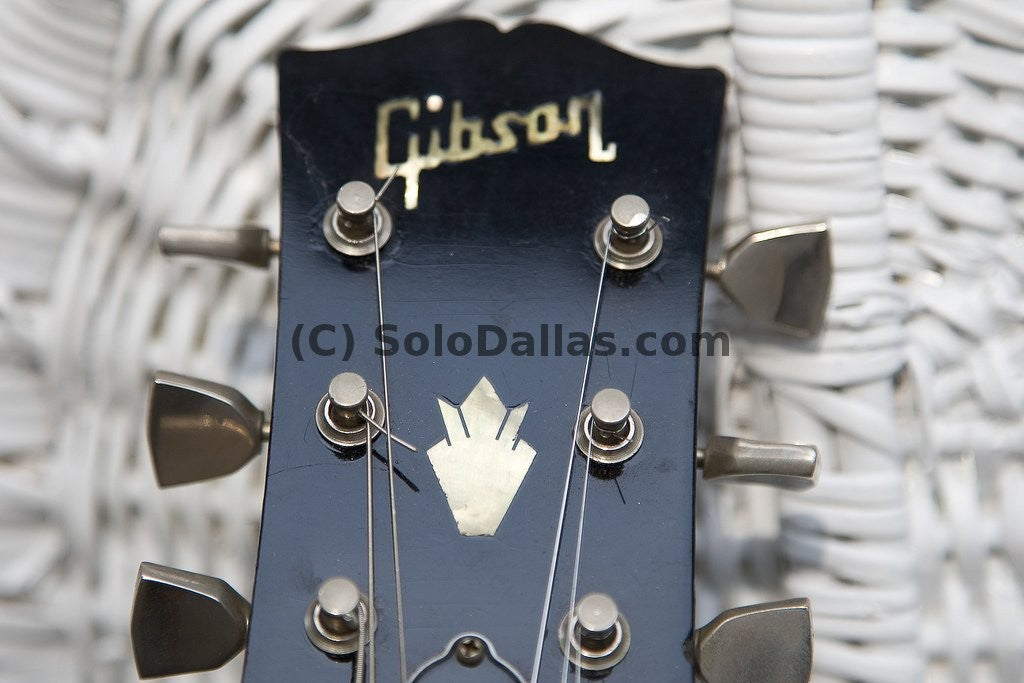This one is a long time friend. It was the second vintage SG - at the time of its purchase - I had ever owned. The first one being a 1971 I had donated to a German friend several years before.
This is a brown (walnut) SG made in late 1969/early 1970. I have shot many of my early videos with this one. The funny thing was that at the time I thought - I had been told so - that this one was a 1968 SG standard (seller told me). For - I think - at least a few years I thought this one a 1968. I was positive about it: in fact, in some of the early videos I shot, I even titled "...with a 1968 SG Standard...". I so much had wanted a 1968, because some sources were stating (among them, Gibson itself)
The hilarious thing was - poor/lucky me - that when I found out this one was not a 1968, I was desperate. At first. I remember it was summer time. I started looking for information everywhere, hectically. I downloaded hundreds of pictures of Angus Young, trying to grasp any detail off of his guitars as closely as I could. Then, some strange, unexpected evidence hit me: his first and most beloved SG was not at all a 1968. I had learned that 1968 SGs look identical to my 1967 SG, and instead, 1970/1971 SGs have their own characteristics. Beginning with the color: in 1970, walnut became standard as a finish color for SG standards. Up to 1969 instead, Cherry Red (a dark cherry red if you ask me, I'd say wine red) had been the standard color and walnut was in fact rare. I noticed that all Angus Young's pictures of the early days (even super early videos!) - when it was known he only had one guitar, that had to be his first one - the guitar itself was undoubtedly of a walnut color. Not a cherry color for sure, not even under heavy show lights. So, an incredible suspect started building up in my mind: the guitar I had always wanted so much, was already in my hands. The disappointment for it not being a 1968 Standard was... a bubble. In short, these (following pictures below) were the images that I shot that very day when the first fears of it not being a '68 ran me over (I shot these pictures in fact to show them in forums where more knowledgeable than me at the time could help me find out): Headstock: tuners were non original here (I had changed them). Now she's got the original tuners (double ring, Kluson) back on.
A detail of the "horns"
Note the very shallow carvings of both cutaways and compare them with the much deeper carvings of early '60s models. This has turned into a good way for me to spot the general era of an SG.
An early "volute". Just slightly visible. I realized there was a volute there after one year I had the guitar.. Probably due to the fact that the guitar is an early 1970.
Detail of the control cavity.
My Vote for Best Modern Production T-Top
SoloDallas Engineer, Dries Potvjin is the ultimate authority on T-Top pickups. He has painstakingly researched every facet of these vintage specimens for decades, measuring every variable and counting every wrap. His SD71 T-Top is widely praised by pros and Gibson afficionados for its authentic vintage qualities. If you are truly interested in discovering a pickup that possesses all of the characteristics and idiosycracies of the best T-Tops ever made, then you must try his SD71. We highly recommend them for vintage restoration projects. I installed them in every vintage SG I own! They are available in every common finish and wiring configuration here:
https://solodallas.com/products/solo71

Note of the author for the more ‘particular’ reader: these articles on SoloDallas’ gear are not intended to be egotistical, neither am I intending to show off. They are for passion, documentation/information and sharing pleasure with those who have a similar interest. Thanks for your trust and understanding, SD











 "
"